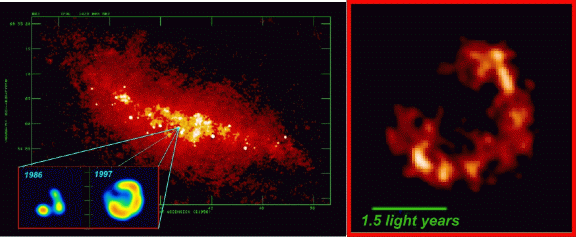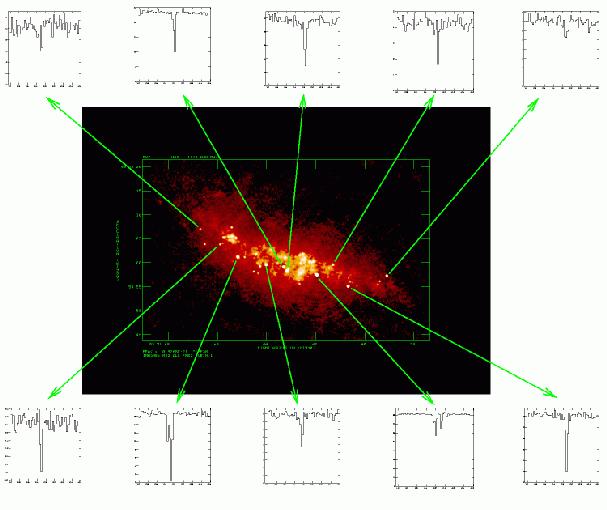Radio studies of starburst galaxies
Our MERLIN, VLA & VLBI studies of starburst galaxies have proved
particularly successful in identifying the supernova remnants which have
arisen as a direct consequence of the high starformation rate. Not only
are these remnants interesting in their own right, but they also enable
the starburst mechanism to be investigated. Using VLBI it is now possible
to study these remnants on scales of around 0.1pc (Pedlar et al 1999) and
measure directly expansion velocities and hence ages. The statistical
properties of these remnants give an independent, and often more reliable,
measure of the star-formation rate (Pedlar 2000).
Click HERE for
press release on M82 VLBI results.
By using atomic hydrogen
and molecular absorption it is possible to probe the neutral gas
distribution & dynamics (eg Wills et al 1998, 2000).
The image below shows selected H1 absorption spectra from Supernova
remnants in M82.
A PhD project in this area can follow up a number of directions such as:
1.) Combination of MERLIN and VLA H1 absorption in M82 with high velocity
resolution. This will enable further studies of gas dynamics in a
barred potential to be carried out. (Data already observed)
2.) Combination of M82 VLA 15GHz B and C config data with A+ array data.
(B +C observed 2001). This can then be compared with existing 5Ghz and
1.4GHz images of M82 to investigate thermal/non-thermal diffuse emission
on parsec scales.
3.) Imaging VLA 90cm data - to be used with project 2, although will be
lower angular resolution
4.) Studies of OH masers and OH absorption in M82 using MERLIN
(observed) and the VLA (applied for)
5.) VLA studies of H1 shells in M82. An initial study (Wills, Pedlar &
Muxlow -MNRAS - in press) found 4 shells. Further work could use VLA B
array to search a wider area and larger shells.
6.) Optical spectroscopy & H1 studies of nearby radio galaxies to
investigate associated starburst activity & understand the evolution of
elliptical galaxies.
7.) Studies of high redshift Starburst galaxies in the Hubble Deep Field.
8.) 1.4 and 5GHz imaging of nearby starburst galaxies initially using
MERLIN. Continuing the work started in Andy McDonald's PhD.
9.) Further VLBI studies of SNR in M82. A second epoch global measurement
has been made at 18cm, together with a 6cm observation particularly aimed
at the most luminous, compact object in M82.
Other projects are in progress, but this is intended to give the flavour
of the project.
Pedlar et al. 1999 MNRAS 307 761
Pedlar 2000 IAU 205 Review
Wills et al. 1998 MNRAS 298 347
Wills et al. 2000 MNRAS 316 33
Supervisors: Dr. Alan Pedlar, Dr. Karen Wills (Sheffield), Dr. Tom
Muxlow


